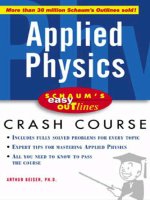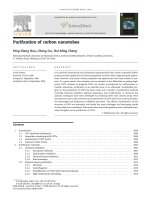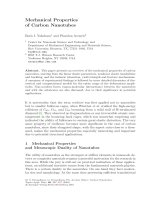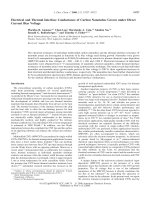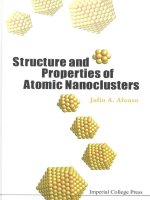- Trang chủ >>
- Khoa Học Tự Nhiên >>
- Vật lý
applied physics of carbon nanotubes, 2005, p.361
Bạn đang xem bản rút gọn của tài liệu. Xem và tải ngay bản đầy đủ của tài liệu tại đây (8.78 MB, 361 trang )
7 F2E=+> 7 )E>)0 7 F20 .+BJ+0( 7 --+ 7 +#>#0!0(#=
)# >#=+#> 02+#0# 0! #)02.2(I +> %2E>#! 20 B)# %>+0B+0( 002*G2=.! /#>2*
>24+ 4)I>+> 0.I>+> G+B) B2/+ =#>2.EB+20 002 0! 9E0BE/*#%%#B !#F+#> 002*
/#)0+> 0! B2/+*>.# 4=2#>>#>7 B)# >+ >4#B> 0! B#)02.2(I*2=+#0B#! !#*
F#.24/#0B> +0 B)+> #/#=(+0( !+>+4.+0# =# 2F#=#! I 2/4=#)#0>+F# 0! B+/#.I 22->7
)# >#=+#> 20>B+BEB#> >E=F#I 2% B)# =#.#F0B >4#+. B24+> G)+) =# 4=#>#0B#! I .#*
!+0( #H4#=B> +0
B)# %+#.!7 )#># 22-> G+ 44#. B2 =#>#=)#=> #0(+0##=> 0! !F0#!
>BE!#0B>7
)I>+. =+0+4.#> 0! 44.+B+20>
I 777 #=>>20
D0! !+B+20
"
0.IB+. #B)2!>
!+B2= 7 +#>#0!0(#=
"
!+B2=> 7 0!2 7 =-G 7 E=EI
7 2/+I/
0! 7 ->)+/
"
BE=#<> 2.EB+20>
I 7 )#=(# 0! 77 2=
!+B2=> 77 G>).2/ 7 /=B)
7 2>>
)I>+> 4#B=2>24I 0! 44.+B+20>
!+B2=> 7 >E/2B2 0! 7 -()=
20#4B> )I>+> 0! #F+#>
!+B2= 7 =E0!/00
"
!+B2=> 7 2=+B 7 +#>#0!0(#=
7 #I#=
"
.#B=20>0!.#B=2/(0#B++#.!>
+002/#B#=*.#B=EBE=#>
!+B2=7#,2
!+B2=>7>E)=7-0+>)+
7>-+
!"
I77))E-+077#!#0B>2F0!7
+/#=(
)#2=I0!2!#.+0(
I7#.#=E#0!70022
00+0(=2#+=2>24I44=2)
!+B2=>7.#H#0!7=EF#=/0
"
!+B2=>724>B#=0!77#4#0
"
E0!/#0B.>2%)#2=I4B+>
0!=0>42=B#F+#>
!+B2=>772B-+00!7E=/20#I
772B-+0
7
7E=/20#I
E0!/#0B.> 2% )#2=I 4B+>
0! =0>42=B #F+#>
+B) DKK +(E=#>
=7 .F 7 2B-+0
#)+() 0+F#=>+BI
#4=B/#0B 2% )I>+>
3@ #/2=+. =+F# >B
#B).#)#/ 3$K3&
*/+. =2B-+0.#)+()7#!E
=7 )#-)= E=/20#I
E20B 2/40I
H4#=+/#0B. BB+20
+./+0(B20 31$$K*KDD$
*/+. >)#-)=7>E=/20#IE>7!E420B72/
=2%#>>2= =7 )#!20 F2E=+>
#>#=) +F+>+20 02/#B#= .# +#0# #)02.2(I
)2/> 7 B>20 #>#=) #0B#= 77 2H D3$
2=-B2G0 #+()B> 3K&1$
=2%#>>2= =7 )=B )E>)0
)+2 BB# 0+F#=>+BI
02B=+2.2(I 2=B2=I %2= 0%2=/B+20 B2=(# 0! A 56
E+B# D&& -#=/0 2! @&K 2.E/E> )+2 'CD3K
=2%#>>2= =7 =#>7 )7 7 .E> F20 .+BJ+0(
H*.0-*0>B+BEB %
"
E= #>B-
"
2=4#=%2=>)E0( #+>#0#=(>B=>># 3
?K&@1 BEBB(=B #=/0I
=2%#>>2= +=2IE-+ --+
0+F#=>+BI 2% 2-I2 0>B+BEB# 2% 0!E>B=+. +#0# '*@*3 2/ #(E=2*-E
2-I2 3&C*$&K& 40
=2%#>>2= =7 2.0! +#>#0!0(#=
0>B+BEB %
"
E= 0(#G0!B# )I>+- 0+F#=>+B
"
B /E=( E0(+E>>B=>># 33
DKC&& /E=( #=/0I
3'C'*'1K'
*3KC*&'K*DC33K*D4=+0(#=#=.+0#+!#.#=(#G2=-
*3C1?$*C*&'K*DC33K*C4=+0(#=#=.+0#+!#.#=(#G2=-
+==I2%20(=#>>20B=2.E/#=DKK'33??CK
)+> G2=-+>>E,#B B2 24I=+()B7 =+()B>=# =#>#=F#!G)#B)#=B)#G)2.#2= 4=B 2%B)# /B#=+. +>
20#=0#!>4#+% + IB)#=+()B>2%B=0>.B+20=#4=+0B+0(=#E>#2%+ E>B=B+20>=#+BB+20=2!>B+0(
=#4=2!EB+2020/+=2%+./2=+00I2B)#=GI0!>B2=(#+0!B0->7E4.+B+202%B)+>4E.+B+202=
4=B>B)#=#2%+>4#=/+BB#!20.IE0!#=B)#4=2F+>+20>2%B)##=/024I=+()BG2%#4B#/#=131@&+0
+B>E==#0BF#=>+200!4#=/+>>+20%2=E>#/E>B.GI>#2B+0#!%=2/4=+0(#=7+2.B+20>=#.+.#B2
4=2>#EB+20E0!#=B)##=/024I=+()BG7
4=+0(#=+>4=B2%4=+0(#=+#0#8E>+0#>>#!+7
>4=+0(#=20.+0#72/
4=+0(#=*#=.(#=.+0#+!#.#=(DKK&
=+0B#!+0#=/0I
)#E>#2%(#0#=.!#>=+4B+F#0/#>=#(+>B#=#!0/#>B=!#/=->#B7+0B)+>4E.+B+20!2#>02B+/4.I
#F#0+0B)#>#0#2%>4#+%+>BB#/#0BB)B>E)0/#>=##H#/4B%=2/B)#=#.#F0B4=2B#B+F#.G>0!
=#(E.B+20>0!B)#=#%2=#%=##%2=(#0#=.E>#7
2F#=-(=2E0!+/(#:+0(.#*G 002BE#+0F#=B#=2=(0+/2.#E.#>G=4=2E0!/#B +
BE#)00#.0!/2!+%I+BB2>#/+20!EB2=G)+.#B)#>#20!BE#+>E>#!%2=(B+0(;720#4B772B-+0
)I>+>#4=B/#0B#)+()0+F#=>+BI+/(#7=2>>#=/(+0(#)02.2(I=2E4#-/00>B+BEB#
7
I4#>#BB+0(0!4=2!EB+20*#=.+0=2B(2*
*=2!EB+20/#=.+0
2F#=!#>+(0#+!#.#=(
=+0B#!20+!*%=##44#= 33KK$1&$ &?AC3'3A*&'CD3K
To my wife, Lolita, and my son, Lev, for their loving support
and patience, and for my mother and grandfather.
Slava V. Rotkin
Foreword
Back in 1991 Sumio Iijima first saw images of multi-walled carbon nanotubes
in the TEM. Two years later, he and Donald Bethune synthesized the first
single-walled nanotubes (SWNTs). Since then, we have seen tremendous ad-
vances in both the methods for nanotube synthesis and in the understanding
of their properties. Currently, centimeter-long SWNTs can be readily grown
at selected positions on a solid substrate, and large quantities of nanotubes
can be produced for industrial applications. Significant progress has been
made in producing nearly homogeneous samples of nanotubes of only a few
diameters/chiralities. It is expected that the development of techniques for
the synthesis of a single type of nanotube is not far away. At the same time,
physical and chemical procedures for the separation of nanotube mixtures
are being demonstrated. In addition to pure nanotubes, derivatized nan-
otubes with attached chemical or biochemical groups are being prepared.
Nanotubes acting as containers for atoms, molecules (such as the “peapods”)
and chemical reactions are attracting significant attention.
In parallel with the synthetic effort there has been a race to decipher the
properties of these materials. It is now clear that nanotubes possess unique
mechanical, electrical, thermal and optical properties. Scientists and engi-
neers around the world are exploring a wide range of technological applica-
tions that make use of these properties. For example, the outstanding mechan-
ical properties of NTs are used in the fabrication of new, strong composites;
their field-emission properties are employed to fabricate flat panel displays;
the ballistic character of electronic transport in SWNT has been utilized to
demonstrate SWNT transistors that outperform corresponding state-of-the-
art silicon devices; while the sensitivity of their electrical characteristics on
interactions with their environment is being used to produce chemical and
biological sensors. Some of these technologies already have matured enough
to enter the market place; others will require much more time. New uses of
carbon nanotubes are continually being proposed, and it would not be an
exaggeration to say that NTs are destined to become the key material of the
21st century.
This book, written by recognized experts in their areas, provides an up-
to-date review of the science and technology of NTs. In the “theory and
modeling” section, S. Rotkin discusses the classical and quantum mechanical
VIII Foreword
behavior of different single-walled nanotube (SWNT) devices. He analyzes
the current-voltage characteristics of long channel SWNT field-effect tran-
sistors operating in the quasi-diffusive regime, and he derives analytical ex-
pressions for both the geometrical and quantum capacitance of SWNTs. He
investigates the changes in electronic structure resulting from the interaction
(charge-transfer) between the SWNT with its substrate and the resulting
breaking of the axial symmetry of the SWNT. He also discusses the possi-
bility of “band-gap engineering” by external electric fields. He finds that an
electric field can open a band-gap in a metallic nanotube, and conversely close
the gap of a semiconducting tube. Ideas for new electronic devices are also
presented. Damnjanovic et al. provide a detailed symmetry-based analysis of
the electronic structure of both single-walled and double-walled nanotubes
(DWNT). The results of simple tight-binding theory and density functional
theory are compared. Using symmetry arguments again, they discuss the op-
tical absorption spectra of nanotubes, SWNT phonons and their Raman and
IR spectroscopies. Finally, the interactions between the walls of DWNTs are
discussed. Analytical continuum models of the acoustic and optical phonon
modes of finite length NTs are provided in the chapter by Stroscio et al.,
where both dispersion relations and mode amplitudes are given.
In the “synthesis and characterization” section of the book, Huang and
Liu discuss the latest developments in the controlled synthesis of SWNTs.
While the heterogeneous NT mixtures produced by various synthetic routes
can be used in a number of applications, high technology applications, such as
those in electronics, require control over the diameter, orientation and length
of the SWNTs. The authors demonstrate the strong relation between cata-
lyst particle size and the diameter of the resulting SWNTs in CVD growth.
They go on to show that oriented growth of NTs can be induced simply
by the laminar flow of the reaction gases. The CVD methods of Hunag and
Liu are based on fast flow of the reaction gases coupled with a fast heating
of the reacting mixture of gases and catalysts. This version of CVD leads
not only to directional growth that allows SWNT structures such as cross-
bars to be generated, but also produces extraordinarily long nanotubes in
the range of centimeters. Then, Okazi and Shinohara discuss the synthesis
and properties of peapods, i.e. the compounds formed by the occlusion of
fullerenes by SWNTs. Occlusion of both simple fullerenes and endohedral
metallo-fullerenes is considered, and structural data and electrical properties
of peapods provided by techniques such as STM, EELS and electron diffrac-
tion are presented. The use of SWNTs as containers for confined chemical
reactions is also discussed. Strano et al. discuss how to use spectroscopic
measurements, absorption, fluorescence and Raman, to study covalent and
charge transfer interactions between small molecules and SWNTs. Examples
discussed include the selective reaction of metallic SWNTs with diazonium
molecules to form aryl C-C bonds and functionalize the side walls of SWNTs,
and the selective protonation of NTs in the presence of oxygen.
Foreword IX
In the section on “optical spectroscopy”, Simon et al. focus on double-
walled CNTs (DWNTs). They discuss the structure of these CNTs us-
ing Raman spectroscopy. They analyze the mechanism of the process by
which SWCNTs incorporating C60, i.e. peapods, are converted into DWNTs
through high energy electron beam irradiation. From Raman spectra they
conclude that the walls of the inner tubes of DWNTs are structurally perfect
and use the splitting of the radial breathing modes to decipher the inter-
action between the two carbon shells. A detailed account of the emission
spectra of NTs is provided by B. Weisman. Fluorescence originating from
the lowest excited state (E11) of SWNTs is readily observed upon resonant
or higher state (e.g. E22) excitation. Weisman explains how, by combining,
fluorescence, fluorescence excitation and resonant Raman spectra of SWNTs
dispersed using surfactants, one can deduce the (n,m) indices that describe
their structure. He points out that the energies of the individual transitions
and the ratios between them show important deviations from expectations
based on single electron tight-binding theory. The environment of SWNTs is
found to affect both the widths and position of the excitation peaks. Such
effects are predicted by theories that account for the many electron effects
and exciton formation. (See also chapter by Avouris et al.)
In the section on “transport, electronic, electro-optical and electro-
mechanical device applications”, Avouris, Radosavljevic and Wind discuss
the electronic structure, electrical properties and device applications of
SWNTs. Special emphasis is placed on SWNT field-effect transistors (SWNT-
FETs). The fabrication, switching mechanism, scaling properties and perfor-
mance of p-, n- and ambipolar SWCNT-FETs are analyzed and compared
with conventional silicon metal-oxide-semiconductor field-effect transistors
(MOSFETs). The key role of Schottky barriers and the critical effects of the
environment on the performance of SWNT-FETs are stressed. Then the na-
ture of the excited states of nanotubes and their optoelectronic properties are
discussed, and single SWNT light emitting and light detecting devices, both
based on the SWNT-FET structure, are demonstrated. The authors suggest
the possibility that a future integrated electronic and optoelectronic technol-
ogy based on SWNTs may be possible. Jagota et al. discuss the interaction
of SWNTs with biological systems. Such interactions are of interest because
they (a) allow the manipulation and sorting of SWNTs, and (b) they can be
used as the basis of sensors for biomolecules. The solubilization of SWNTs by
complexing with DNA is discussed. This interaction is used in the separation
of metallic from the semiconducting SWNTs. The authors also provide evi-
dence that the separation of SWNTs according to their diameter may be pos-
sible by the same technique. A different separation method based on selective
protonation of SWNTs is also discussed. The use of SWNTs as bio-sensors
is demonstrated using the detection of cytochrome C as an example. Finally,
Cumings and Zettl discuss a variety of mechanical and electrical experiments
on multiwall NTs (MWNTs) and boron nitride nanotubes (BNNT). These
X Foreword
include the peeling, sharpening and telescoping of MWNTs inside the TEM.
They use MWNT telescoping as a means to study nanofrictional forces and
determine the static and dynamic frictional components involved. They also
use the same process to determine the length dependence of the conductance
of an NT shell. Under their conditions, they find an exponential dependence
of the resistance on length which they attribute to localization phenomena.
The mechanical properties of NTs are the subject of the chapter by Fisher
et al. The authors discuss in some detail the construction of nanomanipulator
systems which allow the manipulation of NTs and other nanostructures in
3D. They also describe measurements of mechanical properties, such as the
tensile loading of single-wall and multi-wall NTs, the mechanics of carbon
nanocoils, and the results of pull-out tests of single NTs from NT-polymer
matrices.
Yorktown Hights, December 2004 Phaedon Avouris
Preface
Since the discovery of carbon nanotubes about a decade and a half ago by
Sumio Iijima, the scientific community involved in various aspects of research
related to carbon nanotubes and related technologies has observed a steady
progress of the science, as is typical for any new and novel material. Right
from day one, it was apparent to the scientists working on carbon nanotubes
that the chirality of individual nanotubes would dictate their electronic prop-
erties, besides the well-established knowledge that individual sheets of sp2-
bonded carbon had extremely attractive physical and mechanical properties.
So, the field of carbon nanotubes took a giant leap in 1993 when research
groups at NEC and IBM almost simultaneously discovered the single-walled
variant of carbon nanotubes. Since then, we have observed the progress of
science and technology as it relates to carbon nanotubes changing from the
discovery of various methods to synthesize them to their structure-property
relationships to how one might synthesize them in bulk quantities.
A number of edited books have been published in the last five to eight
years outlining a variety of topics of current interest related to carbon nan-
otube research. The chapters in these books deal with topics ranging from
synthesis methods to large-volume production concepts to the studies of the
unique physical and mechanical properties of carbon nanotubes. Some of
the chapters in these books deal with what might be unique about carbon
nanotubes and where one might apply them to real-world commercial ap-
plications of the future. In fact, it is becoming very evident that carbon
nanotubes (specifically single-walled nanotubes with unique electronic prop-
erties) will eventually replace silicon in electronic devices that dominate our
present information/data driven world. Having stated that, the challenges to
selectively obtain and manipulate carbon nanotubes into desired positions in
these devices are enormous, and conventional silicon-based technologies will
essentially be useless to achieve these goals. On a cumulative basis, the chap-
ters in this book deal with a number of these very new challenges related to
carbon nanotubes – how one might go about synthesizing nanotubes of spe-
cific chiralities and/or electronic properties and possible experimental routes
to separate out the desirable nanotubes, and unique and novel measurement
tools to characterize the chiralities of nanotubes. Other chapters deal with
the measurement of the electronic properties of carbon nanotubes and how
XII Preface
these may be used in real devices. Clearly, the authors who have contributed
to this book have done an outstanding job in their respective arenas of inter-
est. From a set-theory point of view, it is our sincerest hope that the reader
will benefit immensely from the wealth of information from the individual
sets (chapters) as well as from the intersection of the various sets.
Urbana–Champaign, Wilmington Slava V. Rotkin
January 2005 Shekhar Subramoney
Contents
Part I Theory and Modelling
1 From Quantum Models to Novel Effects
to New Applications: Theory of Nanotube Devices
S.V. Rotkin 3
1.1 Introduction: Classical vs. Quantum Modelling 3
1.2 ClassicalTerms:Weak Screening in 1DSystems 5
1.2.1 Drift–Diffusion Equation
and Quasi–equilibrium Charge Density 6
1.2.2 Linear Conductivity and Transconductance 7
1.2.3 NumericalResultsandDiscussion 9
1.3 Quantum Terms. I.Quantum Capacitance 11
1.3.1 Statistical Approach
to Calculating Self-Consistent Charge Density
inSWNTinVacuum 13
1.3.2 Green’s Function Approach for Geometric Capacitance . . . 15
1.3.3 ResultsandDiscussion 17
1.4 Quantum Terms. II.Spontaneous Symmetry Breaking 18
1.4.1 Splitting of SWNT Subband Due to Interaction
with the Substrate 18
1.4.2 ChargeInjectionduetothe FermiLevel Shift 21
1.4.3 DipolePolarization Correction 23
1.5 Quantum Terms. III.BandStructureEngineering 25
1.5.1 BandGapOpeningandClosing in UniformFields 26
1.6 Novel Device Concepts:
Metallic Field–Effect Transistor (METFET) 29
1.6.1 Symmetry and Selection Rules in Armchair Nanotubes . . . 30
1.6.2 Gap Opening and Switching OFF: Armchair SWNT 32
1.6.3 Switching OFF Quasi–metallic Zigzag Nanotube 33
1.6.4 Modulation of Ballistic Conductance 34
1.6.5 ResultsandDiscussion 35
References 37
XIV Contents
2 Symmetry Based Fundamentals of Carbon Nanotubes
M. Damnjanovi´c, I. Miloˇsevi´c, E. Dobardˇzi´c, T. Vukovi´c, B. Nikoli´c 41
2.1 Introduction 41
2.2 ConfigurationandSymmetry 42
2.2.1 Single-WallNanotubes 42
2.2.2 Double-WallNanotubes 45
2.3 SymmetryBasedBandCalculations 49
2.3.1 ModifiedWignerProjectors 49
2.3.2 SymmetryandBandTopology 52
2.3.3 Quantum Numbers andSelectionRules 53
2.3.4 ElectronBands 54
2.3.5 ForceConstants PhononDispersions 57
2.4 OpticalAbsorption 60
2.4.1 ConventionalNanotubes 60
2.4.2 TemplateGrown Nanotubes 65
2.5 Phonons 68
2.5.1 Infinite SWNTs 68
2.5.2 CommensurateDouble-WallNanotubes 74
2.6 SymmetryBreaksFriction:Super-Slippery Walls 80
2.6.1 SymmetryandInteraction 80
2.6.2 NumericalResults 82
References 85
3 Elastic Continuum Models of Phonons
in Carbon Nanotubes
A. Raichura, M. Dutta, M.A. Stroscio 89
3.1 Introduction 89
3.2 AcousticModesinSingleWall Nanotubes 90
3.2.1 Model 90
3.2.2 DispersionCurves 94
3.2.3 DeformationPotential 97
3.3 OpticalModesinMulti-wallNanotubes 102
3.3.1 Model 102
3.3.2 NormalizationofLOPhononModes 103
3.3.3 OpticalDeformationPotential 107
3.4 Quantized Vibrational Modes in Hollow Spheres 108
3.5 Conclusions 109
References 109
Contents XV
Part II Synthesis and Characterization
4 Direct Growth of Single Walled Carbon Nanotubes
on Flat Substrates for Nanoscale Electronic Applications
Shaoming Huang, Jie Liu 113
4.1 Introduction 113
4.2 DiameterControl 114
4.3 Orientation Control 118
4.4 Growth of Superlong and Well-Aligned SWNTs
on a Flat Surface by the “Fast-Heating” Process 119
4.5 Growth Mechanism 122
4.6 Advantages of Long and Oriented Nanotubes
forDeviceApplications 129
4.7 Summary 129
References 130
5 Nano-Peapods Encapsulating Fullerenes
Toshiya Okazaki, Hisanori Shinohara 133
5.1 Introduction 133
5.2 High-YieldSynthesisofNano-Peapods 134
5.3 PackingAlignmentofthe FullerenesInsideSWNTs 137
5.4 ElectronicStructuresofNano-Peapods 139
5.5 TransportPropertiesofNano-Peapods 142
5.6 Nano-Peapod as a SampleCellatNanometerScale 144
5.7 Peapod as a “Nano-Reactor” 145
5.8 Conclusions 148
References 148
6 The Selective Chemistry
of Single Walled Carbon Nanotubes
M.S. Strano, M.L. Usrey, P.W. Barone, D.A. Heller, S. Baik 151
6.1 Introduction: Advances in Carbon Nanotube Characterization . . . 151
6.2 Selective Covalent Chemistry
ofSingle-WalledCarbon Nanotubes 153
6.2.1 MotivationandBackground 153
6.2.2 ReviewofCarbonNanotubeCovalentChemistry 153
6.2.3 The Pyramidalization Angle Formalism
for Carbon Nanotube Reactivity 154
6.2.4 The Selective Covalent Chemistry
ofSingle-WalledCarbon Nanotubes 155
6.2.5 Spectroscopic Tools
forUnderstandingSelectiveCovalentChemistry 160
6.3 Selective Non-covalentChemistry:ChargeTransfer 164
6.3.1 Single-WalledNanotubesand Charge Transfer 164
XVI Contents
6.3.2 Selective Protonation of Single-Walled Carbon Nanotubes
inSolution 164
6.3.3 Selective Protonation of Single-Walled Carbon Nanotubes
SuspendedinDNA 169
6.4 Selective Non-covalentChemistry:Solvatochromism 170
6.4.1 Introduction and Motivation 170
6.4.2 Fluorescence Intensity Changes 171
6.4.3 WavelengthShifts 171
6.4.4 ChangestotheRamanSpectrum 174
References 177
Part III Optical Spectroscopy
7 Fluorescence Spectroscopy
of Single-Walled Carbon Nanotubes
R.B. Weisman 183
7.1 Introduction 183
7.2 Observation of Photoluminescence 185
7.3 Deciphering the (n, m )SpectralAssignment 186
7.4 ImplicationsoftheSpectralAssignment 187
7.5 Transition Line Shapes
andSingle-NanotubeOpticalSpectroscopy 192
7.6 Influence of Sample Preparation on Optical Spectra 194
7.7 SpectrofluorimetricSampleAnalysis 195
7.8 Detection, Imaging, and Electroluminescence 198
7.9 Conclusions 200
References 200
8 The Raman Response of Double Wall Carbon Nanotubes
F. Simon, R. Pfeiffer, C. Kramberger, M. Holzweber,
H. Kuzmany 203
8.1 Introduction 203
8.2 Experimental 205
8.3 ResultsandDiscussion 206
8.3.1 Synthesis of Double-WallCarbonNanotubes 206
8.3.2 EnergyDispersive Raman StudiesofDWCNTs 211
References 222
Contents XVII
Part IV Transport and Electromechanical Applications
9 Carbon Nanotube Electronics and Optoelectronics
Ph. Avouris, M. Radosavljevi´c, S.J. Wind 227
9.1 Introduction 227
9.2 Electronic Structure and Electrical Properties
ofCarbonNanotubes 228
9.3 Potential and Realized Advantages of Carbon Nanotubes
inElectronicsApplications 230
9.4 Fabrication and Performance
ofCarbonNanotubeField-EffectTransistors 231
9.5 Carbon Nanotube Transistor Operation in Terms
of a Schottky Barrier Model 235
9.6 The Role of Nanotube Diameter and Gate Oxide Thickness 237
9.7 Environmental Influences on the Performance of CNT-FETs 239
9.8 ScalingofCNT-FETs 241
9.9 Prototype Carbon Nanotube Circuits 242
9.10 Optoelectronic PropertiesofCarbonNanotubes 244
9.11 Summary 248
References 249
10 Carbon Nanotube–Biomolecule Interactions:
Applications in Carbon Nanotube Separation and Biosensing
A. Jagota, B.A. Diner, S. Boussaad, M. Zheng 253
10.1 Introduction 253
10.2 DNA-Assisted Dispersion and Separation of Carbon Nanotubes . . 254
10.3 Separation of Carbon Nanotubes Dispersed
by Non-ionic Surfactant 258
10.4 Structure and Electrostatics of the DNA/CNT Hybrid Material . . 262
10.4.1 Structure of the DNA/CNT Hybrid 262
10.4.2 Electrostatics of Elution of the DNA/CNT Hybrid 264
10.5 Effects of Protein Adsorption on the Electronic Properties
ofSingleWalledCarbon Nanotubes 267
References 270
11 Electrical and Mechanical Properties
of Nanotubes Determined Using In-situ TEM Probes
J. Cumings, A. Zettl 273
11.1 Introduction 273
11.1.1 Carbon andBNNanotubes 273
11.1.2 TEMNanomanipulation 277
11.2 StudiesofCarbonNanotubes 278
11.2.1 Electrically-Induced Mechanical Failure
ofMultiwall CarbonNanotubes 278
XVIII Contents
11.2.2 Peelingand Sharpening Multiwall Carbon Nanotubes 281
11.2.3 Telescoping Nanotubes:
LinearBearingsandVariable Resistors 283
11.3 StudiesofBoronNitrideNanotubes 299
11.4 ElectronFieldEmissionfromBNNanotubes 300
11.5 Electrical Breakdown and Conduction
ofBNNanotubes 302
References 303
12 Nanomanipulator Measurements of the Mechanics
of Nanostructures and Nanocomposites
F.T. Fisher, D.A. Dikin, X. Chen, R.S. Ruoff 307
12.1 Introduction 307
12.2 Nanomanipulators 309
12.2.1 Initial Nanomanipulator Development 309
12.2.2 Recent Nanoscale Testing Stage Development 311
12.3 Nanomanipulator-Based Mechanics Measurements 318
12.3.1 Tensile Loading of Nanostructures 318
12.3.2 InducedVibrationalResonanceMethods 328
12.4 SummaryandFutureDirections 333
References 335
Color Plates 339
Index 345
List of Contributors
Phaedon Avouris
IBM T.J. Watson Research Center
Yorktown Heights, NY 10598, USA
*
S. Baik
118 Roger Adams Laboratory, Box
C-3, 600 South Mathews Avenue,
Urbana, IL 61801, USA
P.W. Barone
118 Roger Adams Laboratory, Box
C-3, 600 South Mathews Avenue,
Urbana, IL 61801, USA
Salah Boussaad
DuPont Central Research and
Development, Experimental Station,
Wilmington, DE 19880, USA
Xinqi Chen
Northwestern University, Depart-
ment of Mechanical Engineering,
2145 Sheridan Road, Evanston, IL
60208, USA
John Cumings
Department of Physics, Stanford
University, Stanford, CA 94305,
USA
*
M. Damnjanovi´c
Faculty of Physics, POB 368, Bel-
grade 11001, Serbia and Montenegro
Dmitriy A. Dikin
Northwestern University, Depart-
ment of Mechanical Engineering,
2145 Sheridan Road, Evanston, IL
60208, USA
Bruce A. Diner
DuPont Central Research and
Development, Experimental Station,
Wilmington, DE 19880, USA
E. Dobardˇzi´c
Faculty of Physics, POB 368, Bel-
grade 11001, Serbia and Montenegro
Mitra Dutta
Department of Electrical & Com-
puter Engineering, Department of
Physics, University of Illinois at
Chicago, Chicago, IL 60607, USA
Frank T. Fisher
Department of Mechanical Engineer-
ing, Stevens Institute of Technology,
Hoboken, NJ 07030, USA
D.A. Heller
118 Roger Adams Laboratory, Box
C-3, 600 South Mathews Avenue,
Urbana, IL 61801, USA
M. Holzweber
Institute of Materials Physics,
University of Vienna, Strudlhofgasse
4, 1090 Vienna, Austria
XX List of Contributors
Shaoming Huang
Department of Chemistry, Duke
University, Durham, NC 27708, USA
Anand Jagota
Department of Chemical Engineer-
ing, Iacocca Hall, Lehigh University,
Bethlehem PA 18015, USA
C. Kramberger
Institute of Materials Physics,
University of Vienna, Strudlhofgasse
4, 1090 Vienna, Austria
H. Kuzmany
Institute of Materials Physics,
University of Vienna, Strudlhofgasse
4, 1090 Vienna, Austria
Jie Liu
Department of Chemistry, Duke
University, Durham, NC 27708, USA
I. Miloˇsevi´c
Faculty of Physics, POB 368, Bel-
grade 11001, Serbia and Montenegro
B. Nikoli´c
Faculty of Physics, POB 368, Bel-
grade 11001, Serbia and Montenegro
Marko Radosavljevi´c
Novel Device Group, Intel Corpora-
tion Hillsboro, OR 97124
*
Toshiya Okazaki
National Institute of Advanced
Industrial Science and Technology
(AIST), Tsukuba, 305-8565, Japan
*
R. Pfeiffer
Institute of Materials Physics, Uni-
versity of Vienna, A-1090 Vienna,
Strudlhofgasse 4., Austria
Amit Raichura
Department of Electrical & Com-
puter Engineering, University of
Illinois at Chicago, Chicago, IL
60607, USA
Slava V. Rotkin
Physics Department, Lehigh Uni-
versity, 16 Memorial Drive East,
Bethlehem PA 18015, USA
*
Rodney S. Ruoff
Northwestern University, Depart-
ment of Mechanical Engineering,
2145 Sheridan Road, Evanston, IL
60208, USA
Hisanori Shinohara
Department of Chemistry and Insti-
tute for Advanced Research, Nagoya
University, Nagoya 464-8602, Japan
and
CREST, Japan Science Technology
Corporation, c/o Department of
Chemistry, Nagoya University,
Nagoya 464-8602, Japan
*
F. Simon
Institute of Materials Physics, Uni-
versity of Vienna, A-1090 Vienna,
Strudlhofgasse 4., Austria
M.S. Strano
118 Roger Adams Laboratory, Box
C-3, 600 South Mathews Avenue,
Urbana, IL 61801, USA
List of Contributors XXI
Michael A. Stroscio
Department of Electrical & Com-
puter Engineering, Department of
Physics, Department of Bioengineer-
ing, University of Illinois at Chicago,
Chicago, IL 60607, USA
M.L. Usrey
118 Roger Adams Laboratory, Box
C-3, 600 South Mathews Avenue,
Urbana, IL 61801, USA
T. Vukovi´c
Faculty of Physics, POB 368, Bel-
grade 11001, Serbia and Montenegro
R. Bruce Weisman
Department of Chemistry, Center for
Nanoscale Science and Technology,
and Center for Biological and
Environmental Nanotechnology,
Rice University, 6100 Main Street,
Houston, TX 77005, USA
*
Shalom J. Wind
Department of Applied Physics and
Applied Mathematics Center for
Electron Transport in Molecular
Nanostructures Columbia University
New York, NY 10027, USA
*
Alex Zettl
Department of Physics, University of
California at Berkeley and Materials
Sciences Division, Lawrence Berke-
ley National Laboratory, Berkeley,
CA, 94720
*
Ming Zheng
DuPont Central Research and
Development, Experimental Station,
Wilmington, DE 19880, USA
Part I
Theory and Modelling
1 From Quantum Models to Novel Effects
to New Applications:
Theory of Nanotube Devices
S.V. Rotkin
Classical and quantum effects in the physics of nanotube devices are pre-
sented. In particular, weak screening in one–dimensional systems is shown
to essentially modify textbook theory of field–effect devices and lead to an
interesting dependence of the device characteristics on geometrical factors.
The capacitance of a nanoscale device has two main components: a classical
geometric capacitance and a quantum term. The latter is related to a finite
density of states of the nanosystem. Derivation of this density of states in
the presence of external perturbations is a difficult task. We present some
examples of the modification of the nanotube bandstructure by external per-
turbations. Electric fields can be used for band gap engineering in nanotubes,
which may be translated into the device function. The concept of the Metallic
Field–Effect Transistor is proposed. This device shows, at least theoretically,
metallic conductance in the ON state and insulating behavior in the OFF
state, which may be important for applications.
1.1 Introduction: Classical vs. Quantum Modelling
One of the expectations of nanotechnology, an area foreseen by Dr. Richard
P. Feynman in 1959 [1], is that we may be able to access quantum properties
of materials, which may ultimately lead to new applications and new device
operations, which are not possible at the macroscale. To enable this new tech-
nology a theory that can make both qualitative and quantitative predictions
is needed, whether it be a classical or quantum theory or a combination of
both. In this chapter we give a few examples and present the quantum vs.
the classical approach using recent results from our modelling of nanotube
based devices.
Carbon nanotubes (NTs), discovered in 1991 [2], nowadays represent a
new class of electronic materials. The electronic properties of NTs depend
on their symmetry [3]. This is not unusual but for a single–wall nanotube
(SWNT) there are just a couple of geometrical parameters: a curvature radius,
R, and a helicity angle (the measure of chirality of the SWNT lattice), which
solely define transport [4], optical [5] and even, to some extent, chemical [6,7]
properties of a SWNT.
4 S.V. Rotkin
Knowledge of these two parameters will allow us to divide all possible
NTs into several distinct classes. Two thirds of SWNTs have a forbidden band
gap, which makes them semiconductors. The band gaps of the semiconductor
SWNTs are in the optical region (near–IR/visible), depending on the value
of R. The experimental fact that, over a wide range of R, the energy gap is
proportional to the curvature, 1/R [5], is a clear manifestation of a simple
quantum effect of a space quantization of an electron. When winding around
the tube circumference, the electron acquires a phase. After making a full turn
the phase has to be 2π, which results in a so–called quantization condition.
The quantization energy sets the separation between the conduction and
valence bands, and therefore the optical gap. In a similar way, as the atomic
size (atomic number) of an element in the Periodic Table solely defines the
properties of the substance, the curvature radius and the helicity angle of a
SWNT define its electronic material properties.
One third of SWNTs are either metals or narrow gap semiconductors (of-
ten called “quasi–metals” in NT literature). The difference between the gap
size in the last two SWNT classes appears in the second order of the cur-
vature, 1/R
2
. The gap in the quasi–metallic SWNT scales as γ/R
2
,where
γ 2.7 eV is the hopping integral which gives the NT energy scale. In the
same second order of the curvature, 1/R
2
, the first SWNT class (semicon-
ductors) splits into two sub–classes by their chirality. All this constitutes a
specific “Periodic Table” of nanotubes.
The other important property of nanotubes relates to their third dimen-
sion: we have already considered the radius and chirality of the tube but not
the length. Recent success in NT synthesis (see also [8]) allowed experimen-
tal study of NTs with R ∼ 1 nm and lengths of about several hundreds to
thousands of microns, which implies an aspect ratio of 1:100,000 and greater.
Certainly, this object must show physics similar to the physics of a one–
dimensional (1D) wire, for example, a weak screening. Below we demonstrate
that the weak 1D screening properties of NTs have important consequences
for electronic devices.
The depth and wide scope of the physics of low–dimensional structures
is due to strong correlations. This is because of the weak screening of the
Coulomb interaction in low–dimensional systems. Indeed, the lowering of the
system dimension from 3D to 2D is typically defined by allowing the Debye
screening length to be larger than one of the system dimensions (the width
of the 2D layer in this case). This results in the underscreening of an external
potential [9], which is further enhanced in the 1D case [10], when the Debye
length is larger than any transverse size of the 1D wire. This effect, though
classical, will be shown to manifest itself and result in non–classical device
behavior.
In the next section we consider two types of 1D objects: semiconductor
nanowires (NWs) and carbon NTs on a common basis. Because the screening
1 Theory of Nanotube Devices 5
properties of these systems are very similar, a universal device theory can be
developed under certain conditions.
The quantum approach is most appropriate in the modelling of nanoscale
systems. Though much simpler, classical models may be also very useful to
understand both material properties and device behavior if these models are
corroborated by a microscopic theory [11]. To give an example, the modelling
of the nanotube/nanowire Nano–Electromechanical Systems (NEMS) [12] re-
quires a knowledge of the elasticity of the material. Clearly, classical elastic
theory may break down at this scale. The use of an atomistic molecular
dynamics to simulate the mechanical response allowed us to parameterize
the stiffness of the tube [13]. Later, this stiffness may be used for classical
continuum level NEMS modelling. Conjugating the atomistic/quantum level
calculations with the lower level continuum/classical modelling constitutes a
multiscale approach, which we will exemplify below.
1.2 Classical Terms: Weak Screening in 1D Systems
Many nanotube or nanowire electronic devices have a common geometry of a
1D Field–Effect Transistor (FET): the 1D channel connects two metal elec-
trodes and is separated by an insulating layer from a backgate (conducting
electrode). An important characteristic of such devices is the ratio between
the transverse size of the nanowire/nanotube (diameter of the channel) and
the Debye screening length in the material. It is typical for a NT or NW that
the Debye screening length is larger than the diameter. Thus, the electrostat-
ics of the system is the electrostatics of a 1D wire. A textbook bulk device
model may fail to obtain carrier densities and electric potential distributions
in the 1D channel properly. In this section we put forward a self–consistent
model to simulate the charge density in 1D FET, stressing the role of the
weak screening in 1D.
In order to isolate and clarify the effect of the weak screening we do not
address ballistic transport models in this section. Some of the short–channel
SWNT FETs were found to be accurately described by the ballistic model (cf.
transport in a Schottky barrier FET in [4]). The ballistic picture may hold
unless very high bias and/or gate voltages are applied and the scattering
length becomes shorter than the channel length. In contrast, results of this
section may be applicable for NT FET, providing the channel is sufficiently
long [14], and for the majority of NW FETs [15–18] where the scattering
length is always short.
It is known that, because of the weak 1D screening, the geometry of the
leads/gates is important for device characteristics. A specific model geometry
for the 1D FET, which we consider here includes the source (x<−L/2) and
drain (x>L/2) electrodes connected by a 1D channel of length L and a gate
electrode separated by a thin dielectric layer of thickness d. We assume the
channel (semiconductor nanowire) to be uniformly doped with a 1D specific
6 S.V. Rotkin
density of impurities, N . The gate voltage V
g
changes the charge density in
the channel controlling the FET transport. We employ the drift–diffusion
model assuming that the scattering rate in the channel is sufficiently high
to support a local charge equilibrium. In the opposite (ballistic) limit (see
[4] and references [12,14,34–36] therein), the channel conductance is rather
unimportant for the current as compared to the Schottky barriers at the leads.
1.2.1 Drift–Diffusion Equation
and Quasi–equilibrium Charge Density
We measure all potentials from the wire midpoint (x = 0), so that the source
and drain potentials are ∓V
d
/2. In this case, the potentials and charge dis-
tributions along the wire caused by V
g
together with the contact potentials
(even) and by V
d
(odd) are, respectively, even and odd functions of x and are
denoted by the subscripts s and a: φ
s,a
(x)andn
s,a
(x).
The potentials φ
s,a
(x) can be divided into two parts: φ
0
s,a
(x) created by
the electrodes and found from the Laplace equation containing no electron
charge, and φ
1
s,a
(x) caused by the electron charge in the wire −en
s,a
(x).
We assume that the characteristic length of charge variation along the wire,
l =min{L, 2d}, noticeably exceeds the wire radius R. In this case, the re-
lationship between φ
1
(x)andn(x) is approximately linear [20–23] and the
current j containing both drift and diffusion components can be written for
the semiconducting NW with non–degenerate carriers in the form [21]:
j
eµ
= n(x)
dφ
0
dx
−
2e
ε
ln
l
R
n(x)+
kT
e
dn
dx
, (1.1)
where n = n
s
+n
a
, φ
0
= φ
0
s
+φ
0
a
, µ is the carrier mobility and ε is the ambient
dielectric permittivity. For a nanotube with N = 0 and degenerate carriers,
kT should be replaced by the concentration–dependent Fermi energy. As a
result, the terms inside the square brackets in (1.1) are replaced by en(x)C
−1
t
with C
t
being the nanotube total capacitance derived in [22]. To obtain this
total capacitance one has to go beyond the classical approximation. In this
section we take C
t
as a parameter of the model to be obtained at a different
level of the multiscale approach as detailed in Sect. 1.3 below.
We solve the differential equation (1.1) with the boundary conditions
n(±L/2) = n
c
assuming a constant charge density is maintained at the con-
tacts, independently of the applied voltage. Two possible boundary condi-
tions allow us to determine the value of current j, so far considered as some
unknown constant. The case n
c
= N corresponds to ohmic contacts not dis-
turbing electric properties of the wire. n
c
>N describes the situation where
the carriers are supplied by electrodes, which is often the case for nanotubes,
and n
c
<N corresponds to Schottky contacts. In the latter case, j is deter-
mined by the contact regions with the lowest charge density n
c
and mostly
independent of V
g
. Thus for the structures adequately described by the clas-
sical drift–diffusion theory (obeying (1.1)), the transconductance will be very
